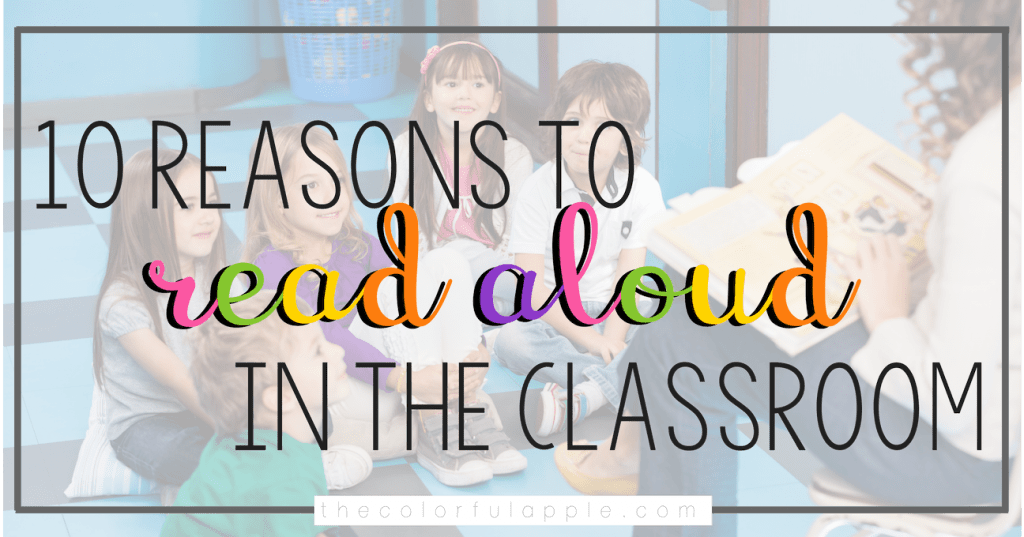Reading books aloud to students is often thought of as an activity that is only seen in primary classrooms. Read alouds, however, are powerful at any age. The benefits of sharing stories with children helps to create life-long readers. And, as teachers, we want students who can read as well as students who do read.
1. Provides children with a reading role model
When we read aloud to children, we are showing them that we enjoy reading as well. That we value books and the joy that they bring to our lives. We are sharing something with them that is special to us and will give us the opportunity to create a common bond.
Students are motivated to read by following the lead of people who read a lot. When they know that we believe reading is for entertainment, they will turn into voracious readers.
2. Fosters a love of books
As students grow older, reading becomes more of a chore. It becomes an assignment to finish. If we read aloud to children, we are sharing with them an activity that is to be treasured for the rest of their lives. We are expressing to them that reading is not just something to “get through,” but something to enjoy.
Reading aloud to children motivates them to read independently for pleasure. The more that they are read to, the more they will want to read.
3. Builds communication skills
Picture books are much richer than ordinary conversation, which will enrich a child’s vocabulary. Listening to a book read aloud introduces them to words they might not hear throughout the day and their vocabulary will be strengthened without effort. Students are able to listen to stories with more complex words than they are capable of reading on their own.
4. Creates an engaged reader
Having an adult read (especially with expression) pulls a child into the magic of a book. Reading needs to be a social experience, giving them the chance to share their feelings about books. A story read aloud allows children to experience the world through someone else’s eyes. Books fuel their curiosity, inspire connections and provide enjoyment.
5. Develops connections between books and real life
As we read aloud to children, we are able to close the gap between what a book is teaching us and how we can apply it to our own lives. It is a great tool for discussing important, yet difficult topics with our children. It acts as a bridge when we cannot find another way to connect.
6. Improves problem solving and critical thinking skills
As children read a book with an adult, they watch and listen as a character faces problems and works through it to solve a problem. As adults, we can help guide children through the process by asking questions and discussing the character’s choices.
7. Brings information naturally to children
Non-fiction books are not typically used as a read-aloud, but they are a wonderful tool to explore with children. Kids are naturally curious and non-fiction texts can help them explore even further. Help them find a topic that they are interested in and choose books to pique that curiosity. When they see that an adult is willing to sit down and learn with them, their engagement will soar!
8. Offers an alternative to technology
Research shows that listening to stories stimulates the imagination significantly more than tv/film. Watching a show is a passive activity, while a story requires the child to be actively listening. As they get older and are listening to books that don’t have pictures, their imagination will soar.
9. Arouses a sense of curiosity and excitement for learning
The more we read aloud to children and share our own excitement, the more engaged they will be in the books that we share. The more we read on our own, the more we stimulate the child’s interest in reading and writing. Pleasure is more often caught than taught.
Reading aloud makes the idea of reading so appealing, that students are drawn to books. It cultivates a natural curiosity and gives them momentum to read more.
10. Improves attention span and listening skills
With every read aloud, a child’s attention span increases. As they become more engaged in books, they’ll be able to sustain themselves for longer periods of time. Reading aloud, then, provides a foundation for learning by nurturing the child’s listening comprehension.
This is just a list of 10 reasons, but there are SO many more! Reading aloud to children is such a crucial part of their development – at any age! What would you add to this list?

Not sure which books to choose for your next read-aloud? Enter your info below and I’ll send you a list of 180+ quality picture books for free!




Leave a Reply
You must be logged in to post a comment.